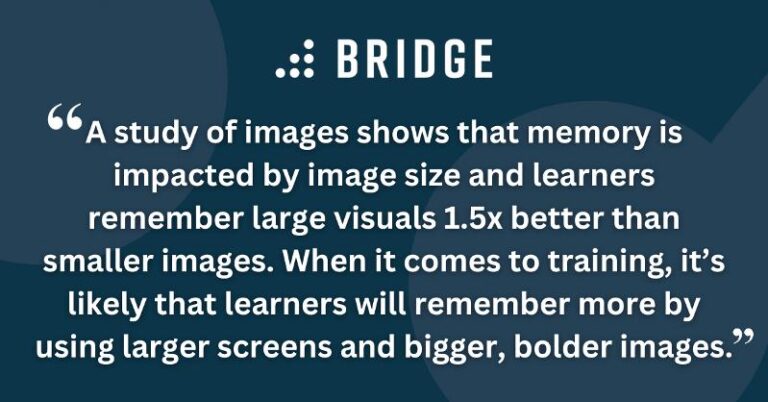Learning and development matters—it keeps your workforce agile and gives them the skills they need for success. They’re also more likely to be motivated and inspired when they have access to training.
To deliver an effective workforce learning program, it’s useful to understand how people learn and retain information.
10 Unforgettable Facts About Learning Retention
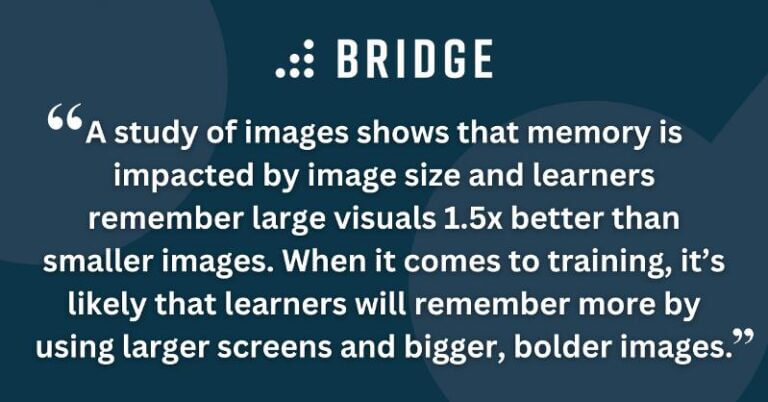
1) Exercise Improves Memory and Skills Learning
Employees should be taking time away from their desks during the day, but there’s evidence that creating healthy routines through exercise can increase memory too. Findings show that bursts of physical activity as short as 15 minutes can improve memory and streamline skills acquisition.
2) Microlearning Drives Learning Retention and Engagement
Microlearning is an effective way to deliver short, targeted pieces of content to learners without overwhelming them, as a study states that short-term memory can only manage around four elements at a time. The same study surveyed learning professionals about their experience of microlearning and found that 71% see its potential to increase knowledge retention and nearly 68% believe it can drive engagement.
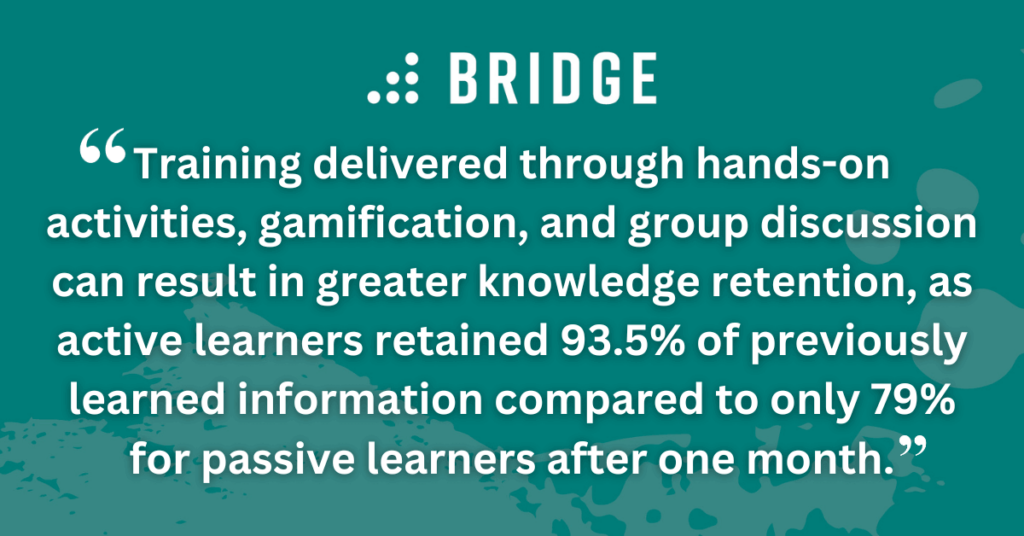
YOU MIGHT ALSO LIKE | ‘How to Launch a Training Program at Your Organization [The Ultimate Guide]’
3) Making Mistakes Can Improve Memory
Mistakes aren’t always a bad thing! According to a phenomenon known as the derring effect, making mistakes on purpose and then correcting them can improve meaningful learning, memory, and test performance. Though learners don’t realize the benefits of making mistakes, results show that learners remembered more of what they’d learned and could apply it more effectively. As you design learning programs, look out for opportunities to let people reflect on their mistakes in a safe place and show them it’s ok to fail.
4) Large Images Make Facts Easier to Remember
A study of images shows that memory is impacted by image size and learners remember large visuals 1.5 times better than smaller images. When it comes to training, it’s likely that learners will remember more by using larger screens and bigger, bolder images.
5) Color Can Make Content 39% More Memorable
How you present your courses matters—findings reveal that adding color to your materials can increase readership rates and help retain information. If you want your learners to engage with content and retain more information, make your courses stand out!
6) Active Learning Increases Competency
Hands-on learning in the workplace is one of the most effective ways to improve competence through learning retention, according to a study on active learning. Training delivered through hands-on activities, gamification, and group discussion can result in greater knowledge retention, as active learners retained 93.5% of previously learned information compared to only 79% for passive learners after one month.
MORE ON COLLABORATIVE LEARNING | ‘5 Great Ways to Encourage Social Learning In the Workplace’
7) Personalized Learning Sticks
Understanding your learners’ motivations, habits, and goals is key to creating personalized journeys. It’s critical to create employee training plans that has set goals and ways you’ll measure success.
8) Repetition Improves Long-Term Memory
Repetition is important and increasing repetition can improve long-term memory by 35%. By repeating key information, learners will more easily be able to call upon the information they’ve already seen.
9) Taking Breaks Helps With Memory Recall
Downtime is essential for health and wellbeing, but it could aid learning retention too. Research shows that when developing a new skill is separated by short periods of rest, the memory becomes stronger and performance develops 20 times faster. Rest allows your people to learn quickly, remember what they’ve been taught, and apply their new skills to the job.
FURTHER READING | ‘How to Boost Employee Wellbeing in the Workplace’
10) Video Captions Increase Understanding by 56%
Visual and text learning don’t have to be an either/or proposition—it turns out they’re more effective when used together. Video captions can increase user comprehension by up to 56%, leading to greater retention.
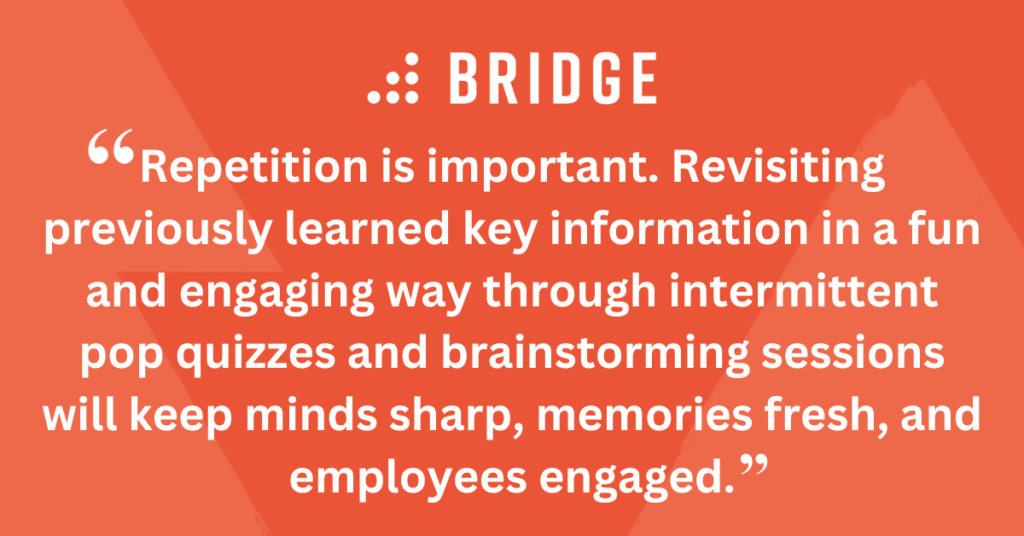
How to Improve Learning Retention in the Workplace
Not all workplace learning is doomed to be forgotten! You have the power to create employee training in a way that encourages information recall and adds value.
Here are some steps you can take to nurture minds with your training programs:
1) Use Video to Train
Mix up content to create a personalized experience. Short, interactive content like video learning will keep engagement up and avoid overloading workers with information. Get learners involved in as much as possible through group sessions, peer-to-peer learning, and on-the-job mentoring. This won’t just drive knowledge retention; it’s also a valuable way to create a sense of community among employees if they work remotely.
MORE TO EXPLORE | ‘4 Ways to Boost Your Learning and Development Strategy for the Hybrid Workplace’
2) Tie Everything Back to Skills
It’s amazing what happens to engagement rates when people can attribute courses or training sessions back to developing a new skill or certification. When you make manager enablement a priority, your organization’s managers are equipped with the right skills to work alongside HR to offer learning that builds skills and leads to professional growth.
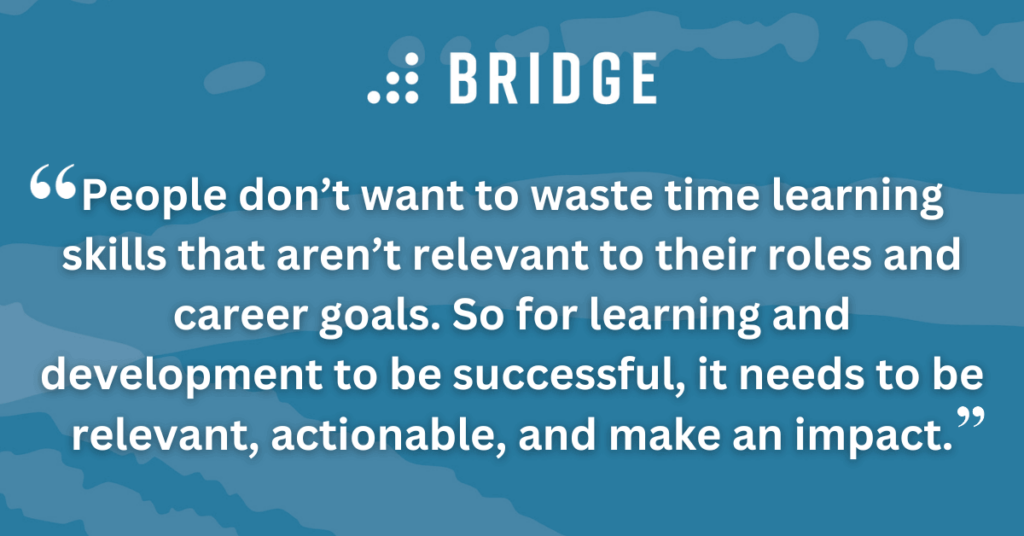
3) Pay Attention to Course Feedback
People don’t want to waste time learning skills that aren’t relevant to their roles and career goals. So for learning and development to be successful, it needs to be relevant, actionable, and make an impact. Metrics and analytics can give you an insight into how well users understand the material through pass rates and how they’re applying it by looking at skill competencies.Listening to your learners is valuable too. Use polls, post-course assessments, and employee engagement surveys to evaluate how effective training courses are, how much of the course material they’ve remembered, and how they feel they apply it in the day-to-day. Always be on the lookout for ways you can tweak courses.
MORE TO EXPLORE | ‘5 Ways to Improve Employee Retention Rate in 2022’
4) Build Personalized Learning Journeys
Your people are individuals with their own learning styles and tactics for remembering information, so giving them the same information in the same format isn’t beneficial. Creating personalized learning journeys based on what each employee wants to achieve and how they learn best means they’re more likely to engage with and remember courses. Managers should build employee development plans to set milestones and help their teams achieve their goals.
5) Create a Culture of Skill Building
Employee development can’t happen in isolation and your people need to feel that they’re part of a culture that respects, values, and facilitates learning. A culture where employees are supported with their development and aren’t afraid to make mistakes is the foundation for success. They should be given the freedom to schedule training around their work and encouraged to play an active role to decide what skills they want to learn based on their career goals. After all, employees who are invested in their own L&D are more likely to be engaged with their training!
FIND OUT HOW TO CREATE A LEARNING CULTURE | ‘Learning to Adapt: How to Put Learning and Development at the Heart of Your Company’s Culture’
Remember Bridge when you need an LMS!
Creating a meaningful learning experience starts with the right tool. Bridge’s learning platform gives you the power to build and deliver unforgettable learning experiences.
Craft personalized journeys to give your learners the training they need in the way they want and create an engaging and memorable experience. With powerful insights and analytics, you can track the success of your training and monitor how well your people learn, retain, and apply their newfound knowledge.
